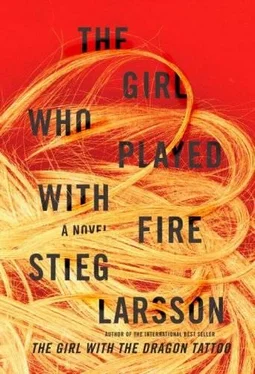Bublanski sighed. Blomkvist was giving him the same story that Miriam Wu had.
“She has to be caught, come what may. I can’t go into the details, but she was at the murder scene, and she has been linked to the murder weapon.”
“I suppose that means you found her fingerprints on it. That doesn’t prove she fired the shots.”
Bublanski nodded. “Dragan Armansky doesn’t believe it either. He’s too cautious to say it straight out, but he’s also looking for proof that she’s innocent.”
“And you? What do you think?”
“I’m a detective. I arrest people and question them. Right now things look dismal for Fröken Salander. We’ve put away murderers on considerably weaker circumstantial evidence.”
“You didn’t answer my question.”
“I don’t know. If she did turn out to be innocent… Who do you think would have a motive for killing both her guardian and your two friends?”
Blomkvist took out a pack of cigarettes and offered it to Bublanski, who shook his head. He did not want to lie to the police. He ought to say something about the man known as Zala. He should also tell Bublanski about Superintendent Gunnar Björck of the Security Police.
But Bublanski and his colleagues had access to Svensson’s material, which contained the same folder. All they had to do was read it. Instead they were charging along like a steamroller and feeding salacious details about Salander to the press.
He had an idea, but didn’t know where it would lead. He didn’t want to name Björck before he was sure. Zalachenko. That was the link between Bjurman and Dag and Mia. The problem was that Björck so far hadn’t told him anything.
“Let me dig a little deeper, then I’ll give you an alternative theory.”
“No police traces, I hope.”
“Not yet. What did Miriam Wu say?”
“Just about the same as you. They had a relationship.”
“None of my business,” Blomkvist said.
“She and Salander have known each other for three years. She says she knows nothing about Salander’s background and didn’t even know where she worked. It’s hard to believe, but I think she’s telling the truth.”
“Lisbeth is obsessively private,” Blomkvist said. “Do you have Miriam Wu’s phone number?”
“Yes.”
“Can I have it?”
“No.”
“Why not?”
“Mikael, this is police business. We don’t need private investigators with wild theories.”
“I don’t have any theories yet. On the other hand, I think the answer lies somewhere in Svensson’s material.”
“You could get in touch with Wu if you made an effort.”
“Probably, but the simplest way is to ask somebody who already has the number.”
Bublanski sighed.
Blomkvist was suddenly very annoyed with him. “Are policemen more talented than normal people, the ones you call private investigators?”
“No, I don’t think that. But the police have the training and it’s their job to solve crimes.”
“Ordinary people have training too,” Blomkvist said slowly. “And sometimes a private investigator is better at working things out than a real detective.”
“So you believe.”
“I know it. Take the Rahman case [3] Joy Rahman was sentenced to life in prison in 1994 for the murder of a seventy-two-year-old woman. He was granted a retrial in 2002, exonerated by the Stockholm Court of Appeal, and received 10.2 million kronor in damages, the largest damages claim ever awarded in Sweden.
. A bunch of policemen sat on their backsides with their eyes closed for five years while Rahman was locked up, innocent of the murder of an old lady. He would still be locked up today if a schoolteacher hadn’t devoted several years to a serious investigation. She did it without the resources you have at your disposal. Not only did she prove that he was innocent, but she also identified the person who in all probability was the real killer.”
“We did lose face in the Rahman case. The prosecutor refused to listen to the facts.”
“Bublanski… I’m going to tell you something. At this very moment you’re losing face in the Salander case as well. I’m damn sure that she did not kill Dag and Mia, and I’m going to prove it. I’m going to produce another killer for you, and when that happens I am also going to write an article that you and your colleagues are going to find painful reading.”
On his way home to Katarina Bangata, Bublanski felt an urge to talk with God about the case, but instead of going to the synagogue he went to the Catholic church on Folkungagatan. He sat in one of the pews at the back and did not move for over an hour. As a Jew he had no business being in a church, but it was a peaceful place that he regularly visited when he felt the need to sort out his thoughts, and he knew that God did not mind. There was a difference, besides, between Catholicism and Judaism. He went to the synagogue when he needed company and fellowship with other people. Catholics went to church to seek peace in the presence of God. The church invited silence and visitors would always be left to themselves.
He brooded about Salander and Wu. And he wondered what Berger and Blomkvist might be withholding from him – certainly they knew something about Salander that they hadn’t told him. What sort of research had Salander done for Blomkvist? For a moment Bublanski considered whether she might have worked on the Wennerström exposé, but then dismissed that possibility. Salander couldn’t have contributed anything of value there, no matter how good she was at personal investigations.
Bublanski was worried: he did not like Blomkvist’s cocksure certainty that Salander was innocent. It was one thing for him as a detective to be beset by doubt – doubting was his job. It was quite another thing for Blomkvist to deliver an ultimatum as a private investigator.
He didn’t care for private investigators because they often produced conspiracy theories, which prompted headlines in the newspapers but also created a lot of unnecessary extra work for the police.
This had developed into the most exasperating murder investigation he had ever been involved in. Somehow he had lost his focus. There had to be a chain of logical consequences.
If a teenager is found stabbed to death on Mariatorget, it’s a matter of tracking down which skinhead gang or other mob was rampaging through Söder station an hour earlier. There are friends, acquaintances, and witnesses, and very soon there are suspects.
If a man is killed with three bullets in a bar in Skärholmen and it turns out he was a heavy in the Yugoslav mafia, then it’s a matter of finding out which thugs are trying to take control of cigarette smuggling.
If a young woman with a decent background and normal lifestyle is found strangled in her apartment, it’s a matter of finding out who her boyfriend was, or who was the last person she talked to at the bar the night before.
Bublanski had run so many investigations like these that he could do them in his sleep.
The current investigation had started off so well. After only a few hours they had found a prime suspect. Salander was practically designed for the role – an obvious psycho case, known to have suffered from violent, uncontrollable outbursts her whole life. It was simply a matter of picking her up and getting a confession or, depending on the circumstances, putting her into psychiatric care.
But after the promising beginning everything had gone to hell. Salander did not live at her address. She had friends like Armansky and Blomkvist. She had a relationship with a lesbian who liked sex with handcuffs, and that put the media in a new frenzy. She had 2.5 million kronor in the bank and no known employer. Then Blomkvist shows up with theories about trafficking and conspiracies – and as a celebrity journalist he has the political clout to create utter chaos in the investigation with a single article.
Читать дальше












